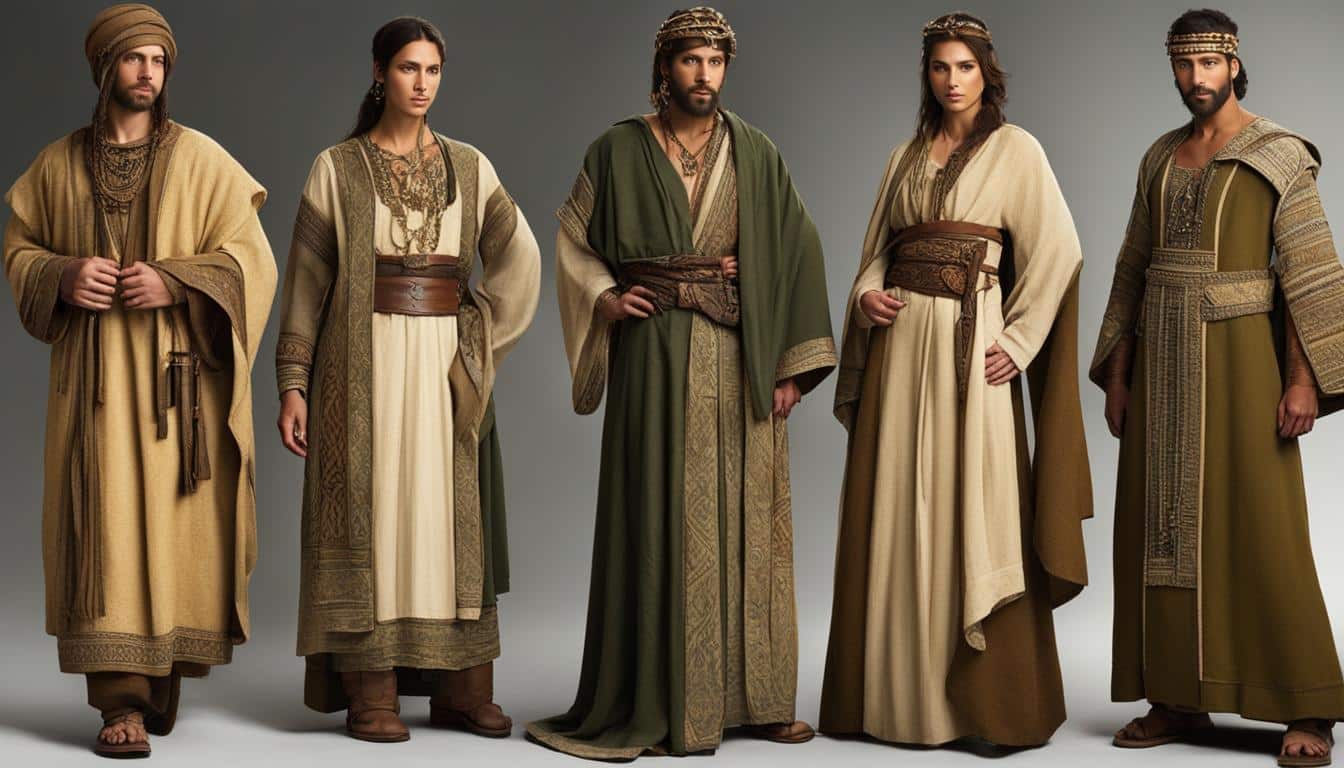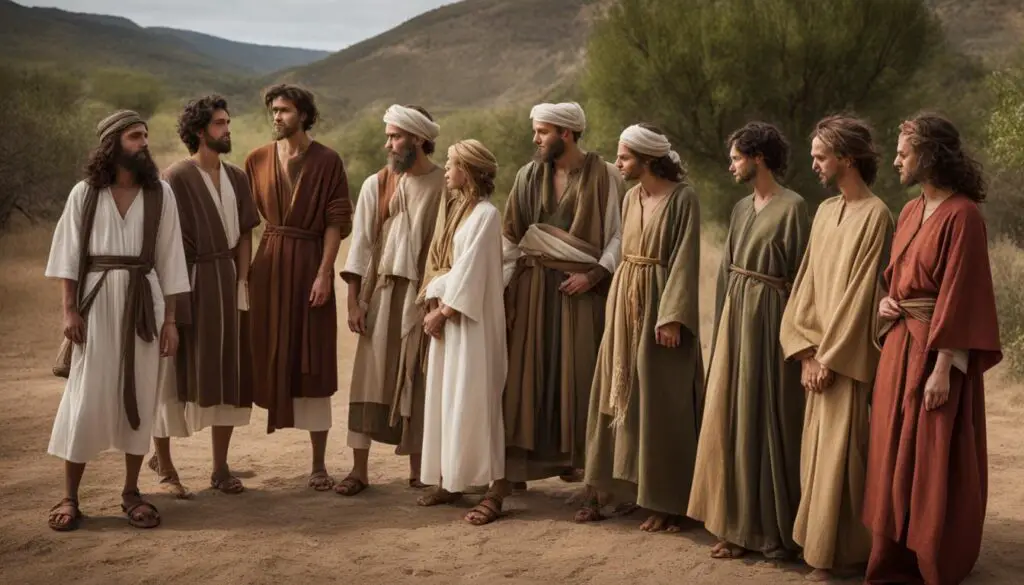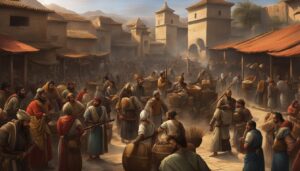
As someone who’s always been drawn to the stories between the verses, I’ve found that clothing in the Bible often carries more than just a practical meaning. What people wore in scripture reveals their status, their purpose, and even their spiritual condition. While studying these garments over the years, I’ve come to appreciate the deep symbolism in robes, sandals, sackcloth, and veils — all woven into stories of transformation, repentance, and divine calling. In this post, I invite you to explore how fashion in biblical times spoke louder than words.
Key Takeaways:
- Clothing in the biblical era was primarily made from wool, linen, animal skins, and silk.
- Hebrew men wore undergarments like the ‘ezor or ḥagor and loose-fitting under-tunics called kethōneth.
- Outer garments like the simlāh and me’īl were worn by men of rank or the priestly order.
- Jewish women’s clothing was similar to men’s but longer, with variations in material, color, and ornamentation.
- Religious accessories such as tassels and phylacteries held spiritual significance.
Symbolism and Significance of Clothing in the Bible
Clothing in the Bible carries symbolic and spiritual significance. It is often used to represent social status, spiritual standing, and as a visual marker of identity. The clothing worn by characters in biblical narratives reflects their roles, personalities, and cultural norms. For example, John the Baptist’s choice of clothing, made of coarse camel hair with a leather belt, communicated his prophetic vision and his role as a contrast to those in luxurious apparel. The parable of the prodigal son depicts the transformation of the wayward son through the father’s act of clothing him in the best robe, signifying his restoration to his rightful status.
Clothing is also used to convey messages and allegorical meanings, such as the mocking crowd adorning Jesus with a costly dyed robe, crown of thorns, and a reed for a scepter to subvert the symbolism of royalty. The clothing references in the Bible add depth and richness to the teachings and narratives, emphasizing the spiritual and symbolic dimensions of clothing in the biblical era.
By examining the significance of clothing in the Bible, we gain a deeper understanding of the cultural context and the deeper symbolism behind the attire worn by biblical figures. It allows us to explore the connections between clothing and identity, social hierarchy, and the spiritual aspects of human existence. The clothing references in the Bible provide valuable insights into the symbolism and importance of attire in biblical times, allowing us to appreciate the layers of meaning embedded within the biblical narratives.

The Significance of Clothing in Biblical Narratives
Clothing plays a vital role in biblical narratives, serving as a visual representation of deeper meanings and spiritual truths. The stories and teachings in the Bible often use clothing as a metaphor, conveying moral lessons and highlighting the importance of righteousness.
“Clothe yourselves with compassion, kindness, humility, gentleness, and patience.” – Colossians 3:12
This quote from the New Testament emphasizes the symbolic nature of clothing, urging believers to adopt qualities that reflect their spiritual identity. Just as physical clothing serves as a visible expression of one’s social standing and identity, Christians are encouraged to “clothe” themselves with virtues that align with their faith.
The Role of Clothing in Expressing Identity
In biblical times, clothing played a significant role in expressing one’s social status and identity. The distinctions between different garments and accessories reflected the wearer’s position in society, whether it was a high-ranking priest, a king, or an ordinary individual.
- The high priest’s intricate garments, complete with precious stones and gold, symbolized their sacred role and closeness to God.
- The simple attire of Jesus and his disciples highlighted their humility and accessibility to all people, regardless of social status.
These examples illustrate how clothing served as a visual marker of one’s role and status, both in religious and secular contexts.
The Spiritual Significance of Clothing
Biblical narratives often use clothing to convey spiritual concepts and remind believers of their higher calling. The act of putting on specific garments or removing certain items of clothing can symbolize a spiritual transformation or a renewed commitment to God.
- In the story of Joseph and his coat of many colors, the coat represents his father’s favor and serves as a symbolic representation of his future role as a leader.
- The reference to putting on the armor of God in Ephesians 6:11-17 symbolizes the spiritual protection and readiness needed to stand against evil forces.
These examples demonstrate the spiritual significance attached to clothing in the Bible, reminding believers of the divine calling and responsibilities they carry.
Clothing as a Visual Reminder
Throughout the Bible, clothing serves as a visual reminder of God’s commandments and the importance of living a righteous life. The specific garments, accessories, and colors mentioned in biblical narratives carry symbolic meanings and encourage believers to align their actions with God’s will.
“These commandments that I give you today are to be on your hearts. Impress them on your children. Talk about them when you sit at home and when you walk along the road, when you lie down and when you get up. Tie them as symbols on your hands and bind them on your foreheads. Write them on the doorframes of your houses and on your gates.” – Deuteronomy 6:6-9
This passage highlights the importance of continuously reminding oneself and future generations of God’s commandments. The visual representation of these commandments through clothing or physical symbols serves as a constant reminder of the values and principles believers should uphold.
| Symbolic Clothing References in the Bible | Meaning |
|---|---|
| The robe of righteousness | Symbolizes purity, forgiveness, and salvation |
| The wedding garment | Represents spiritual readiness and preparedness for the coming of Christ |
| The armor of God | Symbolizes spiritual protection and the ability to stand against evil |
| The seamless robe of Jesus | Reflects Jesus’ unity with the Father and his divine authority |
These symbolic clothing references add depth and meaning to the biblical narratives, reminding believers of the spiritual truths and lessons embedded within the text.
Fashion in the New Testament
The New Testament provides us with valuable insights into the fashion and dress codes of the time, shedding light on the cultural and social contexts of the biblical era. Jesus, known for his impactful teachings, often used clothing imagery to convey spiritual truths and moral lessons. For example, in the Sermon on the Mount, he urged his disciples to consider the lilies of the field, emphasizing the importance of prioritizing God’s kingdom over material possessions.

In the parable of the wedding feast, the concept of wearing the proper wedding garment symbolizes righteousness and spiritual readiness. This imagery emphasizes the significance of one’s inner state and preparedness for the divine. The New Testament also provides detailed descriptions of the clothing worn by high priests and priests in the Tabernacle, highlighting the importance of attire in their sacred duties.
Overall, the references to clothing in the New Testament not only provide us with insights into the fashion and attire of biblical times but also offer deeper symbolic meanings. They help us understand the teachings and events in the life of Jesus, emphasizing the spiritual dimensions of human existence and the importance of righteousness in one’s faith journey.
Conclusion
Attire in biblical times played a significant role in the material culture and social norms of that era. Although the exact clothing styles and details are challenging to reconstruct due to limited evidence, the descriptions and references in the Bible provide valuable insights into the significance of clothing in biblical times.
Clothing served multiple purposes beyond practical necessity, acting as a means of expressing social status, identity, and spirituality. The clothing descriptions found in the Bible offer glimpses into the various garments worn by biblical figures, highlighting their cultural context.
The symbolic meanings attached to clothing in the Bible further demonstrate its importance in conveying moral lessons, emphasizing righteousness, and illuminating the spiritual dimensions of human existence. Exploring clothing and fashion in the Bible allows us to gain a deeper understanding of the attire worn by biblical figures and the cultural significance it held during that time.
FAQ
What materials were used for clothing in ancient Israel?
The people of ancient Israel wore clothing made from wool, linen, animal skins, and silk.
How do we know about the clothing styles of the biblical era?
The clothing styles of the biblical era are mostly known through depictions in Assyrian and Egyptian art.
What were some of the clothing items worn by Hebrew men?
Hebrew men wore undergarments like the ‘ezor or ḥagor, the kethōneth (a loose-fitting under-tunic), outer garments like the simlāh (a heavy shawl), and the me’īl (a cloak worn by men of rank or the priestly order).
How did Jewish women’s clothing differ from men’s?
Jewish women’s clothing was similar to men’s but longer, with variations in material, color, and ornamentation.
What were some important religious accessories for clothing in biblical times?
Important religious accessories included tassels or fringes (ṣiṣit) attached to the corners of garments and phylacteries (tefillin) worn on the forehead and arm.
What kind of footwear did people wear in biblical times?
People in biblical times wore leather sandals as their footwear.
What does clothing symbolize in the Bible?
Clothing in the Bible carries symbolic and spiritual significance, representing social status, spiritual standing, and identity.
How is clothing used to convey messages in biblical narratives?
Clothing in biblical narratives reflects characters’ roles, personalities, and cultural norms. It also conveys allegorical meanings and messages.
How does Jesus use clothing imagery in his teachings?
Jesus often employs clothing imagery to convey spiritual truths and moral lessons, emphasizing the fleeting nature of material possessions and the importance of righteousness and spiritual readiness.
What insights does the New Testament provide about clothing in biblical times?
The New Testament contains references to clothing, including specific details about the attire of high priests and priests. It offers insights into fashion, dress codes, and symbolic meanings associated with clothing in the cultural and social contexts of that time.
What can we learn from exploring clothing and fashion in the Bible?
Exploring clothing and fashion in the Bible provides a deeper understanding of the material culture, social norms, and symbolic dimensions of clothing in the biblical era. It adds richness to the teachings and narratives, highlighting the importance of attire in conveying spiritual truths and moral lessons.
Source Links
- https://en.wikipedia.org/wiki/Biblical_clothing
- https://blog.adw.org/2017/03/sort-clothing-people-jesus-time-wear/
- https://rsc.byu.edu/new-testament-history-culture-society/clothing-textiles-new-testament
Today, clothing might feel like a matter of style or utility, but in biblical texts, it was rarely just that. The garments people wore — or didn’t wear — told a story. As you continue your own journey through scripture, I encourage you to look at the wardrobe details not as decoration, but as revelation. Sometimes the fabric tells the truth the words only hint at.








